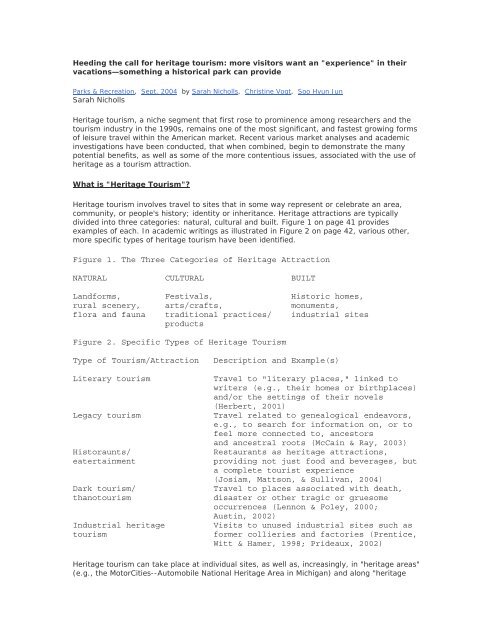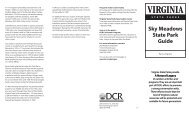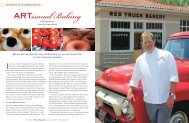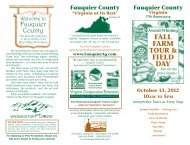Figure 1. The Three Categories of Heritage Attraction NATURAL ...
Figure 1. The Three Categories of Heritage Attraction NATURAL ...
Figure 1. The Three Categories of Heritage Attraction NATURAL ...
Create successful ePaper yourself
Turn your PDF publications into a flip-book with our unique Google optimized e-Paper software.
Heeding the call for heritage tourism: more visitors want an "experience" in theirvacations—something a historical park can provideParks & Recreation, Sept, 2004 by Sarah Nicholls, Christine Vogt, Soo Hyun JunSarah Nicholls<strong>Heritage</strong> tourism, a niche segment that first rose to prominence among researchers and thetourism industry in the 1990s, remains one <strong>of</strong> the most significant, and fastest growing forms<strong>of</strong> leisure travel within the American market. Recent various market analyses and academicinvestigations have been conducted, that when combined, begin to demonstrate the manypotential benefits, as well as some <strong>of</strong> the more contentious issues, associated with the use <strong>of</strong>heritage as a tourism attraction.What is "<strong>Heritage</strong> Tourism"?<strong>Heritage</strong> tourism involves travel to sites that in some way represent or celebrate an area,community, or people's history; identity or inheritance. <strong>Heritage</strong> attractions are typicallydivided into three categories: natural, cultural and built. <strong>Figure</strong> 1 on page 41 providesexamples <strong>of</strong> each. In academic writings as illustrated in <strong>Figure</strong> 2 on page 42, various other,more specific types <strong>of</strong> heritage tourism have been identified.<strong>Figure</strong> <strong>1.</strong> <strong>The</strong> <strong>Three</strong> <strong>Categories</strong> <strong>of</strong> <strong>Heritage</strong> <strong>Attraction</strong><strong>NATURAL</strong> CULTURAL BUILTLandforms, Festivals, Historic homes,rural scenery, arts/crafts, monuments,flora and fauna traditional practices/ industrial sitesproducts<strong>Figure</strong> 2. Specific Types <strong>of</strong> <strong>Heritage</strong> TourismType <strong>of</strong> Tourism/<strong>Attraction</strong>Literary tourismLegacy tourismHistoraunts/eatertainmentDark tourism/thanotourismIndustrial heritagetourismDescription and Example(s)Travel to "literary places," linked towriters (e.g., their homes or birthplaces)and/or the settings <strong>of</strong> their novels(Herbert, 2001)Travel related to genealogical endeavors,e.g., to search for information on, or t<strong>of</strong>eel more connected to, ancestorsand ancestral roots (McCain & Ray, 2003)Restaurants as heritage attractions,providing not just food and beverages, buta complete tourist experience(Josiam, Mattson, & Sullivan, 2004)Travel to places associated with death,disaster or other tragic or gruesomeoccurrences (Lennon & Foley, 2000;Austin, 2002)Visits to unused industrial sites such asformer collieries and factories (Prentice,Witt & Hamer, 1998; Prideaux, 2002)<strong>Heritage</strong> tourism can take place at individual sites, as well as, increasingly, in "heritage areas"(e.g., the MotorCities--Automobile National <strong>Heritage</strong> Area in Michigan) and along "heritage
outes," "corridors" and "trails" (e.g., the Coal Mining <strong>Heritage</strong> Route in southern WestVirginia, South Carolina National <strong>Heritage</strong> Corridor, and Maine Maritime <strong>Heritage</strong> Trail). Insome cases, cities may promote themselves, or districts within them, as heritage destinations,as discussed in Orba_li (2000), Russo (2002) and Litvin (in press).Who Are "<strong>Heritage</strong> Tourists"?<strong>The</strong> number <strong>of</strong> tourists seeking some kind <strong>of</strong> heritage experience during their vacationcontinues to increase. <strong>The</strong> Travel Industry Association <strong>of</strong> America (TIA, 2003) estimates that81 percent <strong>of</strong> the 146.4 million U.S. adults who took a trip (<strong>of</strong> 50 miles or more) in 2002 canbe considered cultural tourists (based on their participation in at least one <strong>of</strong> 15 arts,humanities, historic or heritage events or activities). TIA estimates that historic/cultural travelincreased 13 percent between 1996 and 2000, with trips increasing from 192.4 million to216.8 million, while Marjanaa and Quintos (2001) report an 18 percent increase in spendingon heritage travel between 1995 and 2000. Hargrove (2002) noted that one-third <strong>of</strong>international visitors to the U.$. tour a historic or cultural attraction during their vacation.According to numerous analyses (e.g., Herbert, 2001; Chhabra, Healy, & Sills, 2003; TIA,2003), the typical heritage tourist is <strong>of</strong> middle age or older. and <strong>of</strong> above-average levels <strong>of</strong>education and income. <strong>The</strong> heritage tourist tends to seek more in the type <strong>of</strong> experience andbenefits expected, than other types <strong>of</strong> tourists. <strong>Heritage</strong> tourists "usually seek an informedvisitor experience rather than merely gazing" (Prentice, Witt, & Hamer, 1998, p. 7).<strong>The</strong>y also expect outcomes that include learning about their destination and gaining an insightinto its past. While enjoyment is still crucial, the heritage tourist <strong>of</strong>ten expects a greaterdegree <strong>of</strong> involvement with, or immersion into, the site(s), with a heavy educationalcomponent. <strong>The</strong> heritage tourist may be described as a "thoughtful consumer," one who is <strong>of</strong>above-average cultural competence and wary <strong>of</strong> the "dumbing down" so prevalent in today'sculture (Voase, 2002).Of special interest to tourism providers, the heritage tourist also typically stays longer in anarea than the average tourist, as well as spends more money. <strong>The</strong> TIA study found thatcultural/heritage tourists spent all average <strong>of</strong> $623 per trip, compared to the typical Americantourist's expenditure <strong>of</strong> $457, and that a higher proportion were likely to spend in excess <strong>of</strong>$1,000 (19 percent compared to 12 percent). While the typical tourist's trip lasted 3.4 nights,the cultural/heritage tourist spent an average <strong>of</strong> 5.2 nights at the destination.A recent study conducted by the TIA for" National Geographic Traveler magazine providesfurther evidence <strong>of</strong> the heritage trend (Stueve, Cook, & Drew, 2002). A mail survey <strong>of</strong> 3,300American travelers (defined as adults who had taken at least one trip away from home in thepreceding three years) identified more than one-third <strong>of</strong> the traveling public as geotourists.Geotourism, a concept similar to sustainable tourism, has a primary concern <strong>of</strong> preserving adestination's "geographic character," known as "the entire combination <strong>of</strong> natural and humanattributes that make one place distinct from another" (p. I). <strong>The</strong> researchers found thesegeotourists were searching for travel experiences that were educational, focused on history,nature, culture, and key elements <strong>of</strong> most heritage <strong>of</strong>ferings.In the study, the geotourism sector included three distinct market segments: geo savvys(10.6 percent <strong>of</strong> the sample), urban sophisticates (13.8 percent), and good citizens (1<strong>1.</strong>4percent). Table 1 on page 42 presents a comparison among these three groups and the entiresample in response to a series <strong>of</strong> statements concerning trip characteristics, motivations andexpectations. All three segments exhibited above-average levels <strong>of</strong> travel activity (asmeasured by average number <strong>of</strong> trips taken per annum) as well as above-average levels <strong>of</strong>household income, indicating not only the desire but also the means to engage in their desiredtypes <strong>of</strong> tourism on a relatively" frequent basis.
Strategic Marketing & Research, Inc. (SMRI, 2000) conducted a national telephone survey <strong>of</strong>800 Americans, entitled <strong>The</strong> Image Study, for the National Scenic Byways Organization in thesummer <strong>of</strong> 2000. Of special interest to heritage route managers, they found that 76 percent <strong>of</strong>respondents would rather take a more interesting travel route, even if it were longer,compared to 24 percent who would always take the fastest option. Fourteen percent <strong>of</strong> thosesurveyed indicated that they "<strong>of</strong>ten" went on driving tours <strong>of</strong> various areas and sites withouthaving a single destination in mind, while another 53 percent replied that they took such tours"every once in a while." Increased domestic, and especially auto-based travel in the wake <strong>of</strong>9/11, and a weak economy <strong>of</strong>fer increased opportunities for heritage attraction providers tocapitalize on the convergence <strong>of</strong> heritage interests and pleasure/sightseeing driving trends.What Are <strong>The</strong> Benefits <strong>of</strong> <strong>Heritage</strong> Tourism)?<strong>Heritage</strong>-based travel, like all segments <strong>of</strong> the tourism industry, <strong>of</strong>fers the potential fornumerous economic benefits in destination areas. <strong>The</strong> attraction <strong>of</strong> new visitors to a site orarea increases spending and may lead to the creation <strong>of</strong> new jobs and businesses, therebystimulating the local economy both directly and indirectly, through the multiplier or trickledowneffect. Taxes on spending can be used to benefit all members <strong>of</strong> a community, not justthose directly involved in the tourism industry, through the improvement <strong>of</strong> physicalinfrastructure.In addition to the economic benefits that the attraction <strong>of</strong> tourists to a heritage site or areacan generate, the recognition <strong>of</strong> such locations may also bring with it a number <strong>of</strong> otheradvantages. Identification <strong>of</strong> a site or area as <strong>of</strong> historic, cultural or natural importance shouldpromote greater awareness <strong>of</strong>, and appreciation for, its value, thereby increasing the chances<strong>of</strong> its preservation in the future. Realization <strong>of</strong> the existence and significance <strong>of</strong> its uniqueresources by local residents is likely to enhance community pride and help strengthen sense <strong>of</strong>place and identity, as evidenced by Besculides, Lee, and McCormick (2002) in their analysis <strong>of</strong>the perceptions <strong>of</strong> residents <strong>of</strong> the Los Caminos Antiguos Scenic and Historic Byway insouthwestern Colorado.<strong>Heritage</strong> sites provide real-world classrooms where both children and adults--local andvisitors--can learn about the history, nature and/or culture <strong>of</strong> an area. Beyond theseopportunities for education regarding the site or wider vicinity, lies the additional potential forincreased awareness and understanding <strong>of</strong> resource preservation. Pretes (2003) describes themore pr<strong>of</strong>ound impact that heritage sites can have on the formation and maintenance <strong>of</strong>national identity among domestic visitors. <strong>Heritage</strong> sites can <strong>of</strong>fer nostalgic images <strong>of</strong>traditional lifestyles, as well as <strong>of</strong> the progress <strong>of</strong> a region or country.<strong>Heritage</strong>-based tourism can also be tied into the notion <strong>of</strong> sustainability. <strong>The</strong> creation <strong>of</strong>tourism attractions using existing assets--whether natural, cultural, or built--negates the needfor the building <strong>of</strong> new facilities, allowing communities to "look to the past for a sustainablefuture" (Hargrove, 2002, p. 10).Other IssuesWhile <strong>of</strong>fering many advantages to both local communities and the traveler, the developmentand promotion <strong>of</strong> heritage tourism also presents a number <strong>of</strong> potentially problematic issues.One topic that has received an immense amount <strong>of</strong> attention concerns the notions <strong>of</strong>authenticity and commodification, in this case referring to the genuineness or legitimacy <strong>of</strong> asite or story, and its alteration for commercial purposes. Seminal pieces by Boorstin (1991),MacCannell (1976) and Urry (1992), have spawned a number <strong>of</strong> more recent, empiricalexaminations <strong>of</strong> these issues in the context <strong>of</strong> heritage tourism. At issue is the degree towhich representations <strong>of</strong> the past are truly faithful to reality, and whether there is potential forthe alteration <strong>of</strong> portions, or even entire, pasts so as to increase market appeal by makinghistory more pleasant and rosy (Prentice, Witt, & Hamer, 1998; Goulding, 2002; du Cros,2001; Austin, 2002; Chhabra, Healy, & Sills, 2003). Though problems are most commonly
seen at the more commercial end <strong>of</strong> the market, authenticity and commodification are <strong>of</strong> equalconcern at smaller sites.In contrast, however, other sites have faced the opposite problem: the complete lack <strong>of</strong> anyconsideration <strong>of</strong> the visitor's experience in favor <strong>of</strong> conservation and guardianship, a"curatorial approach." This method sometimes resents the mere presence <strong>of</strong> tourists, and maystill be found in some muse urns and galleries where the emphasis remains on thepreservation <strong>of</strong> heritage rather than its everyday enjoyment (Garrod and Fyall, 2000).Nevertheless, this attitude may well change as the need to retain financial solvency in the face<strong>of</strong> declining governmental support becomes ever more pressing, and the economic benefits <strong>of</strong>public access--at the market price--become more evident to heritage managers. Thus,managers face the challenge <strong>of</strong> providing an experience that strikes a balance betweenobvious simulation and sensationalism, and an overly dry, scholarly air. <strong>The</strong> heritage visitorseeks an educational, yet equally enjoyable visit to a site that presents accurate informationyet in a stimulating manner (Goulding, 2002).On a more practical level, as the tourism industry--heritage-related and otherwise--continuesto burgeon, and visitor expectations (both in terms <strong>of</strong> the quality and range <strong>of</strong> attractionsexpected) continue to increase, competition between destinations becomes ever more fierce.<strong>Heritage</strong> sites must compete for visitors not only within the heritage market, but also againstother forms <strong>of</strong> leisure activity (theme parks, shopping malls, entertainment complexes, etc.),as suggested by Garrod and Fyall (2000) and Hargrove (2002).As stated by Prideaux (2002, p. 380), "possession <strong>of</strong> an interesting landscape, old building,unique event or historic site is no guarantee that tourism will flourish ... Success lies beyondpreservation <strong>of</strong> the past and construction <strong>of</strong> the new to celebrate the old. Success has muchmore to do with the decidedly unnostalgic issues <strong>of</strong> marketing, pulling power, viability andinformed management." a clear vision <strong>of</strong> a site's purpose, <strong>of</strong> its potential visitors and theirexperiences, is therefore essential, and should be outlined in the marketing plan for the area.A cohesive plan is also more apt to encourage broad community support, and to attractfunding from relevant agencies, two other vital elements <strong>of</strong> a successful, tourism-baseddevelopment strategy.Sarah Nicholls is an assistant pr<strong>of</strong>essor, Christine Vogt is an associate pr<strong>of</strong>essor, and SooHyun Jun is a master's student, in the Department <strong>of</strong> Community, Agriculture, Recreation andResource Studies (formerly Park, Recreation and Tourism Resources) at Michigan StateUniversity. <strong>The</strong> authors recently completed a marketing plan for the US-12 <strong>Heritage</strong> Route,which passes through the southern portion <strong>of</strong> Michigan.Table <strong>1.</strong> Selected Results from TIA Geotourism StudyAllGeo-Characteristic Travelers SavvysPercentage <strong>of</strong> American travelers (adultswho had taken at least one trip in thepreceding three years) 100 10.6Average number <strong>of</strong> trips taken per year 5.2 7.6Average annual household income($,thousands) 62.7 68.2Percent aged 35-54/55 and over 43/27 50/25Percent holding college education(at least one degree) 45 61Statement Geo- Urban(figures represent percent agreement) Travelers Savvys
My travel experience is better when mydestination preserves its natural, historicand cultural sites and attractions 61 81My travel experience is better when I'mseeing or doing something authentic 40 60My travel experience is better when I havelearned as much as possible about mydestination's customs, geography and culture 53 72<strong>The</strong>re should be more public and/or privatefunding for preservation <strong>of</strong> our nation'shistoric sites and monuments 59 76Very/extremely important that trip provideseducational experiences for me/family 55 73Very/extremely likely to visit historicsites and/or museums in my local area 40 65Very/extremely likely to take trips todestinations that have authentic historic 52 83or archeological buildings/sitesUrbanGoodCharacteristic Sophisticates CitizensPercentage <strong>of</strong> American travelers (adultswho had taken at least one trip in thepreceding three years) 13.8 1<strong>1.</strong>4Average number <strong>of</strong> trips taken per year 6.4 5.8Average annual household income($,thousands) 76.6 70.6Percent aged 35-54/55 and over 50/25 25/50Percent holding college education(at least one degree) 63 63StatementGood(figures represent percent agreement) Sophisticates CitizensMy travel experience is better when mydestination preserves its natural, historicand cultural sites and attractions 77 63My travel experience is better when I'mseeing or doing something authentic 54 44My travel experience is better when I havelearned as much as possible about mydestination's customs, geography and culture 74 61<strong>The</strong>re should be more public and/or privatefunding for preservation <strong>of</strong> our nation'shistoric sites and monuments 78 66Very/extremely important that trip provideseducational experiences for me/family 61 66Very/extremely likely to visit historicsites and/or museums in my local area 57 75Very/extremely likely to take trips todestinations that have authentic historic 73 53or archeological buildings/sitesSource: Stueve, Cook, & Drew (2002).References
Andereck, K., & Vogt, C. (2003). Arizona Office <strong>of</strong> Tourism, Arizona Welcome (,'enter StudyInterim Report. Phoenix, AZ: Department <strong>of</strong> Recreation and Tourism Management, ArizonaState University West.Austin, N.K. (2002). Managing heritage attractions: Marketing challenges at sensitive historicalsites. International Journal <strong>of</strong> Tourism Research, 4 (6), 447-457.Besculides, A, Lee, M.E., & McCormick, P.J. (2002). Residents' perceptions <strong>of</strong> the culturalbenefits <strong>of</strong> tourism Annals <strong>of</strong> Tourism Research, 29(2), 303-319.Boorstin, D (1991) <strong>The</strong> Image: A Guide to Pseudo-Events in America New York: Vintage.Chhabra, D., Healy, R, & Sills, E. (2003). Staged authenticity and heritage tourism Annals <strong>of</strong>Tourism Research, 30(3), 702-719du Cros, H, (2001). A new model to assist in planning for sustainable cultural heritagetourism. International Journal <strong>of</strong> Tourism Research, 3(2), 165-170.Everett, G. (2001). <strong>Heritage</strong> tourism: Selling or celebrating our soul? Only in Butte. Availableonline at http//www.butteamerica.com/heritour.htm.Garrod, B., & Fyall, A. (2000) Managing heritage tourism. Annals <strong>of</strong> Tourism Research, 27(3),682-708.Goulding, C. (2002). <strong>The</strong> commodification <strong>of</strong> the past, postmodern pastiche, and the searchfor authentic experiences at contemporary heritage attractions. European Journal <strong>of</strong>Marketing, 34(7), 835-853.Hargrove, C. (2002). <strong>Heritage</strong> tourism Cultural Resource Management, 25(1), 10-1<strong>1.</strong>Herbert, D (2001) Literary places, tourism and the heritage experience Annals <strong>of</strong> TourismResearch, 28(2), 312-333.Josiam, B.M., Mattson, M., & Sullivan, P. (2004). <strong>The</strong> Historaunt: <strong>Heritage</strong> tourism at Mickey'sDining Car. Tourism Management, 25(4), 453-46<strong>1.</strong>Lennon, J., & Foley, M. (2000) Dark Tourism: <strong>The</strong> <strong>Attraction</strong> <strong>of</strong> Death and Disaster. London:Continuum.Litvin, S.W. (in press) Streetscape improvements in an historic tourist city, A second visit toKing Street, Charleston. South Carolina. Tourism Management.MacCannell, D. (1976) <strong>The</strong> Visitor A New <strong>The</strong>ory <strong>of</strong> the Leisure Class New York CambridgeUniversity Press.MacKay, K.J., Andereck, K.L., & Vogt, C.A. (2002). Understanding vacationing motorist nichemarkets. Journal <strong>of</strong> Travel Research, 40, 356-363.Marjanaa, L., & Quintos, N. (2091). Digging for roots National Geographic Traveler, 18, 28-29.McCain, G., & Ray, N.M. (2003) Legacy tourism: <strong>The</strong> search for personal meaning in heritagetravel. Tourism Management, 24, 713-717.
Michigan State University, Department <strong>of</strong> Parks, Recreation, and Tourism Resources (1999)Michigan Motorists, A Survey <strong>of</strong> Travel Michigan Welcome Center Visitors, Fourth <strong>of</strong> July toLabor Day, 1998 Report conducted for Travel Michigan, Michigan Jobs Commission, byDepartment <strong>of</strong> Parks, Recreation, and Tourism Resources, Michigan State University, EastLansing, MI.Orba_li, A. (2000). Tourists In Historic Towns: Urban Conservation And <strong>Heritage</strong> Management.London: E&FN Spon.Prentice, R.C., Witt, S.F., & Hamer, C. (1998). Tourism as experience: <strong>The</strong> case <strong>of</strong> heritageparks. Annals <strong>of</strong> Tourism Research, 25(1), 1-24.Prates, M. (2003). Tourism and nationalism. Annals <strong>of</strong> Tourism Research, 30(1), 125-142.Pirdeaux, R. (2002) Building visitor attractions in peripheral areas--can uniqueness overcomeisolation to produce viability? International Journal <strong>of</strong> Tourism Research, 4(5), 379-389.Russo, A. P. (2002) <strong>The</strong> "vicious circle" <strong>of</strong> tourism development in heritage cities Annals <strong>of</strong>Tourism Research, 29(1), 165-182.Strategic Marketing & Research, Inc. (2000). <strong>The</strong> Image Study.Stueve, A.M., Cook, S.D., & Drew, D. (2002). <strong>The</strong> Geotourism Study. Phase I ExecutiveSummary. Report prepared by <strong>The</strong> Research Department <strong>of</strong> the Travel Industry Association <strong>of</strong>America, Washington, DC, for National Geographic Traveler.Travel Industry Association <strong>of</strong> America (2093) <strong>The</strong> Historic/Cultural Traveler, 2003 Edition.Travel Industry Association <strong>of</strong> America/Smithsonian Magazine. Available to purchase athttp://www.tia. org//Pubs/pubs.asp?PublicationID=16.Urry, J. (1992) <strong>The</strong> Visitor Gaze Leisure and Travel in Contemporary Societies. London: Sage.Voase, R. (2002). Rediscovering the imagination: Investigating active and passive visitorexperience in the 21st century. International Journal <strong>of</strong> Tourism Research, 4(5), 391-399.RESEARCH INTO ACTION: HERITAGE TOURISM RESOURCES<strong>The</strong> increasing interest in heritage and associated types <strong>of</strong> travel has resulted in a rapid rise inthe number <strong>of</strong> resources--at both the national and state level--available to help communitiesand other entities establish, market and manage heritage-based attractions. A variety <strong>of</strong> thesenational and state-based agencies and organizations are identified below, as is a list <strong>of</strong>forthcoming conferences focusing on these issues.NATIONAL RESOURCES<strong>The</strong> National Trust for Historic Preservationwww.nationaltrust.org* <strong>The</strong> Trust's <strong>Heritage</strong> Tourism Program <strong>of</strong>fers a fee-for-service consultancy through supportfrom the National Endowment for the Arts. <strong>The</strong> program <strong>of</strong>fers assistance at the heritagetourism development process, from assessing the potential <strong>of</strong> a site, community, or largerarea, to planning, marketing, and managing attractions, and publicizing success stories.
* <strong>The</strong> Trust is also involved in the Share Your <strong>Heritage</strong> program, which has published two sets<strong>of</strong> case studies highlighting successful heritage tourism development, "Share Your <strong>Heritage</strong>:Cultural <strong>Heritage</strong> Tourism Success Stories" and "Stories Across America: Opportunities inRural Tourism."U.S. Department <strong>of</strong> Transportation Federal Highway Administration's National Scenic BywaysProgramwww.bywaysonline.org* America's Byways[TM], has provided funding for approximately 1,500 projects since itsinception in 199<strong>1.</strong> Roads--recognized either as M-American Roads or National Scenic Byways--are selected for inclusion based on one or more <strong>of</strong> their archeological, cultural, historic,natural, recreational or scenic qualities. Funding for byway-related projects is awardedannually on a merit basis through the National Scenic Byways Discretionary Grant program.* Public visitors can also sign up to receive a quarterly e-newsletter as well as a free, hardcopy map <strong>of</strong> the 96 byways currently in the system.National <strong>Heritage</strong> Areaswww.nationalheritageareas.org* Only 24 such areas, which are established by Congress, currently exist, each exhibitingphysical landscapes and/or human traditions <strong>of</strong> national distinction.* <strong>The</strong> Alliance <strong>of</strong> National <strong>Heritage</strong> Areas represents the NHAs, with the dual goals <strong>of</strong>enhancing the quality <strong>of</strong> life <strong>of</strong> NHA citizens and communities end attracting national andinternational visitors to the sites.National Register <strong>of</strong> Historic Placeswww.cr.nps.gov/nr/* A listing <strong>of</strong> more than 77,000 districts, sites, buildings, structures and objects <strong>of</strong> nationalhistorical, architectural, archeological, engineering, and cultural significance.STATE RESOURCES<strong>The</strong> range <strong>of</strong> resources available within individual states varies in size and diversity, andreaders are advised to search for specific agencies and organizations relevant to theirparticular location and concerns. <strong>The</strong> examples given below are illustrative rather thanexhaustive. Resources listed pertain only to the state level; many more programs exist at thecounty and local scales, e.g., through Downtown Development Associations (DDAs),Convention and Visitors Bureaus (CVBs), Destination Marketing Organizations (DMOs) andlocal historic preservation associations.StateAgency/Organization and Program Web AddressAK Alaska Department <strong>of</strong> Natural www.dnr.state.ak.us/parks/oha/Resources, Office <strong>of</strong> History www.dnr.state.ak.us/parks/oha/and Archaeology, Historicgrant/akdev.htmPreservation Fund,Predevelopment and DevelopmentProject Grants
AR Arkansas Historic Preservation www.arkansaspreservation.org/Program, Preservation Services preservation/default.aspAZ Arizona Humanities Council www.azhumanities.org/General Grants and We theggrants<strong>1.</strong>htmlPeople Initiativewww.azhumanities.org/wethepeople.htmlCO Colorado Community www.ccraonline.org/CHAP/Revitalization Association,Colorado <strong>Heritage</strong> AreaPartnershipCT Connecticut Humanities Council www.ctheritage.com/FL Florida Division <strong>of</strong> Historical dhr.dos.state.fl.us/ResourcesVisit Florida, New Product www.visitflorida.org/index.Developmentcfm?fla=web&webpageid=97GA Governor's Commission on www.gahistory.uga.edu/Georgia History and HistoricalTourismIL Illinois Department <strong>of</strong> www.illinoistourism.org/Commerce and Economicind_heritage.htmlOpportunity, <strong>Heritage</strong> TourismProgramKS Kansas Humanities Council www.kansashumanities.org/<strong>Heritage</strong> Programgrants/heritage/heritage.htmlKansas Sampler Foundation, www.kansassampler.org/wekan/Tourism Alliancestourism.htmlKentucky <strong>Heritage</strong> Council/ www.state.ky.us/agencies/khc/Kentucky Department <strong>of</strong> Travel/ khchome.htmKentucky TransportationCabinet, Kentucky Cultural and<strong>Heritage</strong>Driving Trails Signage Program tourism.ky.gov/highway.aspMD Maryland Department <strong>of</strong> Housing www.marylandhistoricaltrust.and Community Development,net/hb-<strong>1.</strong>htmlDivision <strong>of</strong> Historical andCultural Programs, <strong>Heritage</strong>Preservation and Tourism AreasProgramME Maine Arts Commission, Arts www.mainearts.com/and <strong>Heritage</strong> Tourism Program organizations/tourism/index.shtmlMI Michigan Department <strong>of</strong> www.michigan.gov/mdot/Transportation, <strong>Heritage</strong>0,1607,7-151-9621_Route Program11041_11209--,00.htmlMS Mississippi Division <strong>of</strong> www.visitmississippi.not/TIP/Tourism, <strong>Heritage</strong> andTIPStaffDirectory.htmCultural ProgramMS Arts Commission, <strong>Heritage</strong> www.arts.state.ms.us/Program Grantsguidelines_msheritage.htmlMT Travel Montana, Tourism www.travelmontana.org/OUR-Development and Education,PROGRAMS/TourismDevEd.htmCultural Tourism ProgramNC North Carolina Department <strong>of</strong> www.nccommerce.com/tourism/Commerce, <strong>Heritage</strong> Tourismheritage/ProgramND North Dakota Department <strong>of</strong> www.ndtourism.com/Resources/
Commerce, Tourism Division, viewArticle.asp?choice=Tourism Development Assistance &ID=185NH New Hampshire Land & Community www.lchip.org/<strong>Heritage</strong> Investment ProgramNJ New Jersey Historic Trust www.njht.org/NM New Mexico <strong>Heritage</strong> www.nmheritage.org/Preservation AllianceNY <strong>Heritage</strong> New York Program www.heritageny.state.ny.us/index.htmArts & Business Council Inc. www.artsandbusiness.org/and NY State Council on the culturaltourism/index.htmArts, Cultural TourismInitiative and Grant ProgramOH <strong>Heritage</strong> Ohio www.heritageohio.org/Ohio Department <strong>of</strong>www.odod.state.oh.us/Development, Division <strong>of</strong>Travel.htmTravel and Tourism, Ohio<strong>Heritage</strong> Tourism InitiativeOK Preservation Oklahoma www.charityadvantage.com/POK/Oklahoma Tourism andHome.asptourism.state.ok.us/Recreation Department,Divisions <strong>of</strong> Research& Development, and Travel &TourismOR Oregon Parks and Recreation hcd.state.or.us/Department, <strong>Heritage</strong>ConservationPA Pennsylvania Bureau <strong>of</strong> www.dcnr.state.pa.us/brc/Recreation and Conservation, heritageparks/Department <strong>of</strong> Conservation and www.ruralpa.org/Natural Resources, <strong>Heritage</strong> news0503.html#1Parks Program Center for RuralPennsylvania, Framework for<strong>Heritage</strong> Tourism DevelopmentRI Rhode Island Historical www.rihphc.state.ri.us/Preservation and <strong>Heritage</strong>CommissionSC South Carolina Department <strong>of</strong> www.discoversouthcarolina.com/Parks, Recreation and Tourism, agency/grantsheritage<strong>Heritage</strong> Corridor Development corridor.aspGrantsTX Texas Historical Commission, www.thc.state.tx.us/heritage<strong>Heritage</strong> Trails Programtourism/htprogram.htmlUT Department <strong>of</strong> Community and culturalheritage.utah.gov/Economic Development,Community Cultural <strong>Heritage</strong>Coordinating CouncilVT Vermont Arts Council, Vermont www.vermontartscouncil.org/Cultural <strong>Heritage</strong> Tourismservices/cultural_heritage.ToolkithtmlWY Wyoming Department <strong>of</strong> wydotweb.state.wy.us/web/Transportation Scenic Byways business/sbw.htmland Backways ProgramForthcoming Events<strong>The</strong> 2004 National Extension Tourism Conference
People, Places and Partnerships: Keys to Success,Sept. 27-30, Kissimmee, Fla.http://srdc.msstate.edu/04tourism/index.html<strong>The</strong> 2005 International <strong>Heritage</strong> Development ConferenceJune 5-8, Nashville, Tenn.http://www.cr.nps.gov/heritageareas/REP/IHDCProp.pdf.<strong>The</strong> Second International Conference on Maritime <strong>Heritage</strong>April 18-20, 2005, Barcelona, Spainhttp://www.wessex.ac.uk/conferences/2005/mh05/index. htmlCOPYRIGHT 2004 National Recreation and Park AssociationCOPYRIGHT 2004 Gale Group









